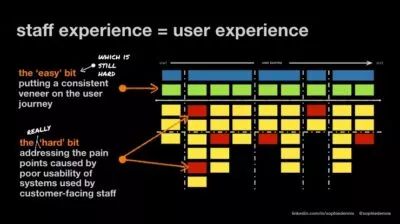11 Sep 2023
- Public Services
Customer centricity, employee experience and the public sector

During Customer Centricity Month 2022, we had the pleasure of hosting Sophie Dennis at our Employee Experience webinar. Sophie talked about why customer centricity is relevant to the public sector, why employee experience matters to the end user experience in public services, and what you can do about it.
-
Amanda Payne
Experience Strategy Director
Amanda Payne
Amanda’s foreword
During Customer Centricity Month 2022, we had the pleasure of hosting Sophie Dennis at our Employee Experience webinar. Sophie talked about why customer centricity is relevant to the public sector, why employee experience matters to the end user experience in public services, and what you can do about it.
Sophie Dennis is a Design Director specialising in building high-performing user centred design teams. Between 2021 and 2023, she set up the 120-strong in-house human centred design capability for NHS Test & Trace from scratch to respond to the COVID-19 pandemic.
At cxpartners, we believe that centring around the customer within the public sector can make a real difference to strategy, governance and people.
It can be incredibly useful, in certain circumstances, to move conversations away from ‘user’ or even ‘people’ or ‘humans’. All public sector services should be designed to meet user needs and solve the whole problem. However, this places user centred design and the end user at the ‘service’ level where user centred design thinking is aligned to specific roles in a larger multi-disciplinary team. Because of systemic shortcomings, the team and decisions are largely structured around the product or service rather than the wider system or organisation. Our Customer Centricity Model takes a more ‘whole system’ approach and has demonstrable benefits to the organisation, its employees and the customers.
Sophie, and her experience in NHS Test & Trace, has opened up a conversation about the word ‘customer’ in the public sector. Over the next few months, cxpartners will be exploring more deeply the benefits (and challenges) of customer centricity in the public sector.
Next week at SDinGov 2023 we will be diving into the topic with Germaine Faulkner, Customer Experience and Service Design Lead at the Civil Aviation Authority, we’d love to see you there!
Why customer centricity is relevant to the public sector
Sophie believes that the NHS Test & Trace brought together the best of the private and public sector. One thing the private sector brought in was the concept of a Chief Customer Officer who sits at board level and reports directly to the Chief Executive as the voice of the customer. It’s a function that integrates user centred design and product, marketing, communication, innovation and insights into a coherent customer function.
Using the word ‘customer’ to apply to people who use public services can be problematic. Some people in the public sector find this uncomfortable as a term to use. They may worry that attempts are being made to privatise public services. However, the Chief Customer Officer for NHS Test & Trace helped them to reframe the customer in the public sector as ‘the people we are here to serve’.
Sophie defined customer centricity in the public sector as ‘prioritising creating value for the people they serve over other organisational considerations such as reputation, short-term profit, cost reduction, or delivery deadlines’. Similar to what it says in the Agile Manifesto – it’s not that those things don’t matter, but that by prioritising customer value, the other things will follow.
So why invest in employee experience? If an organisation wants to be customer centric, shouldn’t they prioritise investment in things that directly impact customers? But improving the user experience of internal tools and systems used by the frontline customer-facing staff affects all those other dimensions of the customer centricity model.
What you can do as a CX leader
As a customer experience leader, to have the most impact on the employee experience, there are two priority aspects on which to focus. The first is improving the user experience of internal tools and systems used by frontline customer-facing staff – that classic ‘front to back’ of service design where things behind the scenes prevent us from creating a great experience for end users. Secondly is reducing friction for your design and research team through practices like design and research ops and operational tooling.
Improving internal tools and systems
It is apparent in the NHS that the user experience of the software systems used by clinicians and support staff is equally as crucial to the patient experience as the patient-facing digital tools. The ‘easy’ bit is putting the consistent front-end veneer on the customer-facing tools – to make them look joined up even when they aren’t joined up under the hood.
But there are limits to how far you can ‘paper over the cracks’ with front-end digital tools. Eventually, the places where back-end systems don’t join up prevent the NHS from offering patients the needed experience. Sophie’s team saw this in discovery work on appointment bookings and referrals. A lot of the ‘pain’ for patients in the appointment and referral process was due to the limitations of the software that staff used for managing them and the workarounds they deployed.
Productivity
In the NHS, not only does the staff experience of the systems they use daily directly impact patient experience, but it also affects patients in other ways, namely staff productivity and clinical quality and safety.
Despite common misconceptions, there are more staff in the NHS today than there were a few years ago. The issue with the NHS is not just that there aren’t enough staff; it’s that they don’t have the infrastructure needed to do their jobs efficiently and effectively.
There is chronic underinvestment in IT and digital, from basic equipment to usability of bespoke and custom software. The NHS spends less than 2% of its budget on technology, compared with the recommended 5%. As a result, staff frequently have to log into multiple systems. Computers are old and slow, and basic kit like keyboards often don’t work. It can sometimes take up to half an hour to log on in the mornings. In some departments, minor improvements to IT would have a significant leveraging effect.
Sophie led a review of the user experience of digital in urgent and emergency care. At the time, there were roughly five million A & E attendances to 181 departments in the UK. A senior clinician estimated that if you took one minute extra for each of those five million visits for a doctor or nurse to enter patient information, that added up to a total of 200 doctor shifts per year that you were either taking extra or that you could save. For some systems, it took 3.5 to 4 minutes to enter patient information; at the other end of the scale, it could take 12 minutes. So in A & E, where you’re seeing hundreds of patients a day, and turnover and flow are critical, it can have a massive impact.
Clinical quality and safety
The impact of usability on clinical quality and safety can be a grave yet hidden issue. The quality of clinical decision-making depends on doctors and clinicians being able to rapidly access and absorb large quantities of information. They need to be able to see essential patient information all in one place. However, patient records are held in multiple locations meaning they have to log into numerous systems separately to access a patient’s information. Sadly when doctors don’t get that information because all the systems they’re using aren’t usable, patient safety has been seriously compromised, leading to tragic incidents.
Fundamentally it’s about giving staff who work on the frontline the tools they need to do their job and the tools they need to serve patients and communities effectively.

Reducing friction for your design and research team
When Sophie was initially setting up the Test & Trace Human Centred Design team, she knew they needed to scale and that they required dedicated support based in the Dept Health and Social Care, which had no in-house user research capability. So Sophie hired a Research Ops Lead and a Talent Manager as the first members of a wider Design Ops team. Working within a large bureaucracy, having people dedicated to cutting through that and joining it all up was incredibly valuable and significantly impacted how quickly and efficiently people could work.
In summary, Sophie’s advice was to focus on what is doable, not what is ‘perfect’. There are some things you simply cannot change. By giving your UX and design teams the tools they need, you can enable them to do their jobs. However, if you can’t give people all the IT and software they want because of ‘bureaucracy’, your greatest gift as a design leader is giving your team time, space and permission to do their work. Ultimately, giving people the right tools to do their job and permission to do it signals that you trust them.






